+ Open data
Open data
- Basic information
Basic information
| Entry | Database: PDB / ID: 2l4w | ||||||
|---|---|---|---|---|---|---|---|
| Title | NMR structure of the Xanthomonas VirB7 | ||||||
 Components Components | Uncharacterized protein | ||||||
 Keywords Keywords | PROTEIN TRANSPORT / Type IV secretion system / VirB7 / N0 domain / MEMBRANE PROTEIN / Xanthomonas / Lipoprotein / Bacterial outer membrane | ||||||
| Function / homology | Phage tail protein beta-alpha-beta fold - #70 / Toxin co-regulated pilus biosynthesis protein Q, C-terminal / Toxin co-regulated pilus biosynthesis protein Q / Phage tail protein beta-alpha-beta fold / 3-Layer(bab) Sandwich / Alpha Beta / Toxin co-regulated pilus biosynthesis protein Q C-terminal domain-containing protein Function and homology information Function and homology information | ||||||
| Biological species |  Xanthomonas axonopodis pv. citri (bacteria) Xanthomonas axonopodis pv. citri (bacteria) | ||||||
| Method | SOLUTION NMR / torsion angle dynamics, simulated annealing cartesian dynamics | ||||||
| Model details | lowest energy, model 1 | ||||||
 Authors Authors | Souza, D.P. / Farah, C.S. / Salinas, R.K. | ||||||
 Citation Citation |  Journal: Plos Pathog. / Year: 2011 Journal: Plos Pathog. / Year: 2011Title: A Component of the Xanthomonadaceae Type IV Secretion System Combines a VirB7 Motif with a N0 Domain Found in Outer Membrane Transport Proteins. Authors: Souza, D.P. / Andrade, M.O. / Alvarez-Martinez, C.E. / Arantes, G.M. / Farah, C.S. / Salinas, R.K. | ||||||
| History |
|
- Structure visualization
Structure visualization
| Structure viewer | Molecule:  Molmil Molmil Jmol/JSmol Jmol/JSmol |
|---|
- Downloads & links
Downloads & links
- Download
Download
| PDBx/mmCIF format |  2l4w.cif.gz 2l4w.cif.gz | 698.3 KB | Display |  PDBx/mmCIF format PDBx/mmCIF format |
|---|---|---|---|---|
| PDB format |  pdb2l4w.ent.gz pdb2l4w.ent.gz | 587.9 KB | Display |  PDB format PDB format |
| PDBx/mmJSON format |  2l4w.json.gz 2l4w.json.gz | Tree view |  PDBx/mmJSON format PDBx/mmJSON format | |
| Others |  Other downloads Other downloads |
-Validation report
| Summary document |  2l4w_validation.pdf.gz 2l4w_validation.pdf.gz | 345.6 KB | Display |  wwPDB validaton report wwPDB validaton report |
|---|---|---|---|---|
| Full document |  2l4w_full_validation.pdf.gz 2l4w_full_validation.pdf.gz | 460.2 KB | Display | |
| Data in XML |  2l4w_validation.xml.gz 2l4w_validation.xml.gz | 32.5 KB | Display | |
| Data in CIF |  2l4w_validation.cif.gz 2l4w_validation.cif.gz | 56.9 KB | Display | |
| Arichive directory |  https://data.pdbj.org/pub/pdb/validation_reports/l4/2l4w https://data.pdbj.org/pub/pdb/validation_reports/l4/2l4w ftp://data.pdbj.org/pub/pdb/validation_reports/l4/2l4w ftp://data.pdbj.org/pub/pdb/validation_reports/l4/2l4w | HTTPS FTP |
-Related structure data
- Links
Links
- Assembly
Assembly
| Deposited unit | 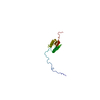
| |||||||||
|---|---|---|---|---|---|---|---|---|---|---|
| 1 |
| |||||||||
| NMR ensembles |
|
- Components
Components
| #1: Protein | Mass: 12871.409 Da / Num. of mol.: 1 / Fragment: VirB7-Xac2622, UNP residues 24-139 Source method: isolated from a genetically manipulated source Source: (gene. exp.)  Xanthomonas axonopodis pv. citri (bacteria) Xanthomonas axonopodis pv. citri (bacteria)Strain: 306 / Gene: XAC2622 / Production host:  |
|---|
-Experimental details
-Experiment
| Experiment | Method: SOLUTION NMR Details: Solution structure of the VirB7 protein coded by the Xanthomonas Type IV Secretion System | ||||||||||||||||||||||||||||||||||||||||||||||||||||||||||||||||||||||||||||||||||||
|---|---|---|---|---|---|---|---|---|---|---|---|---|---|---|---|---|---|---|---|---|---|---|---|---|---|---|---|---|---|---|---|---|---|---|---|---|---|---|---|---|---|---|---|---|---|---|---|---|---|---|---|---|---|---|---|---|---|---|---|---|---|---|---|---|---|---|---|---|---|---|---|---|---|---|---|---|---|---|---|---|---|---|---|---|---|
| NMR experiment |
|
- Sample preparation
Sample preparation
| Details |
| ||||||||||||||||||||||||||||
|---|---|---|---|---|---|---|---|---|---|---|---|---|---|---|---|---|---|---|---|---|---|---|---|---|---|---|---|---|---|
| Sample |
| ||||||||||||||||||||||||||||
| Sample conditions |
|
-NMR measurement
| NMR spectrometer |
|
|---|
- Processing
Processing
| NMR software |
| ||||||||||||||||||||||||||||||||||||||||||||
|---|---|---|---|---|---|---|---|---|---|---|---|---|---|---|---|---|---|---|---|---|---|---|---|---|---|---|---|---|---|---|---|---|---|---|---|---|---|---|---|---|---|---|---|---|---|
| Refinement | Method: torsion angle dynamics, simulated annealing cartesian dynamics Software ordinal: 1 Details: 300 structures were calculated using the program Cyana. 50 structures with lowest target function were selected for further refinement., 50 Cyana structures were refined in explicit solvent ...Details: 300 structures were calculated using the program Cyana. 50 structures with lowest target function were selected for further refinement., 50 Cyana structures were refined in explicit solvent using the HADDOCK program. 20 lowest energy structures were selected. | ||||||||||||||||||||||||||||||||||||||||||||
| NMR constraints | NOE constraints total: 2056 / NOE intraresidue total count: 438 / NOE long range total count: 663 / NOE medium range total count: 382 / NOE sequential total count: 573 / Protein chi angle constraints total count: 0 / Protein other angle constraints total count: 0 / Protein phi angle constraints total count: 60 / Protein psi angle constraints total count: 60 | ||||||||||||||||||||||||||||||||||||||||||||
| NMR representative | Selection criteria: lowest energy | ||||||||||||||||||||||||||||||||||||||||||||
| NMR ensemble | Conformer selection criteria: structures with the lowest energy Conformers calculated total number: 300 / Conformers submitted total number: 20 |
 Movie
Movie Controller
Controller



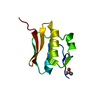
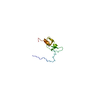


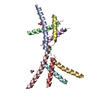
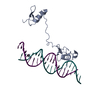
 PDBj
PDBj
 HSQC
HSQC